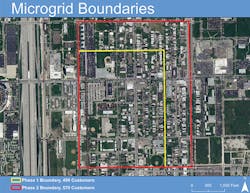For the better part of a year after Hurricane Maria devastated Puerto Rico, hundreds of thousands of people still did not have electricity, a reminder that being prepared for the worst can be the only way to mitigate it. Microgrids represent a critical technology to help provide the resilience capabilities communities need to either prevent these long-term outages or restore service afterward. Electric utilities around the world are developing strategies to leverage this technology in the best way.
For more than 100 years, Commonwealth Edison Co. (ComEd) has continued to power the lives of customers across northern Illinois, including most of the Chicago metropolitan area, whose nearly 10 million people make it the third-largest metropolitan area in the U.S. The ComEd service territory is prime for all types of extreme weather, which can wreak havoc on electrical distribution systems. The utility is located adjacent to Tornado Alley, and weather systems such as derechos, torrential rain and ice storms are not uncommon. Many industry references, including the Chicago Climate Action Plan, suggest the changing climate will result in more frequent and more intense weather events. If unprepared, these low-frequency but potentially high-impact events can result in substantial damage.
Microgrids, as defined by the U.S. Department of Energy (DOE), are a group of interconnected loads and distributed energy resources (DERs) within clearly defined electrical boundaries that acts as a single controllable entity with respect to the grid. A microgrid can connect and disconnect from the main grid to enable operations in both grid-connected or island mode. This technology already has proven its worth in the aftermath of large resiliency events such as the Tohuku earthquake in Fukushima, Japan, when — despite the tsunami and nuclear disaster that followed it — two small microgrids continued to provide service to customers, including a retirement home. And it was microgrids that kept the lights on for portions of university campuses in New York and New Jersey in the aftermath of Superstorm Sandy.
Microgrid Proposal
The goal of enhanced resiliency is why ComEd is driving for deployment of microgrid technology. To identify locations in its service area that would benefit the most from increased resilience, ComEd performed a holistic data-driven analysis of its entire service territory. Using the U.S. Public Land Survey System (PLSS), the utility divided its service territory into nearly 13,000 subsections. Each subsection was evaluated based on the following factors:
• Existing reliability
• Capacity for future growth
• Condition of its substation
• Presence of critical infrastructure that could need added resilience capabilities.
With this process concluded, ComEd initiated a proceeding with the Illinois Commerce Commission to install a 7-MW microgrid in the Bronzeville neighborhood of Chicago. Based on the analysis, the utility selected Bronzeville because it could get considerable resilience benefits and it neighbored an existing microgrid serving the Illinois Institute of Technology. This would enable ComEd to demonstrate and test the clustering capability of a microgrid controller for which it had received the first of two grants from the DOE. By clustering the two microgrids together and enabling ComEd’s microgrid master controller to operate both, it would be possible to share resources for more efficient operation.
The Illinois Commerce Commission determined the benefits of the project were not limited to customers within the project footprint and those it directly affected, but that the learnings gained through the project would "benefit every customer who takes electric delivery service in an increasingly complicated distribution-system environment."
Phase I: 2.5-MW Microgrid
The Bronzeville Community Microgrid (BCM) will be the first utility-operated clustered microgrid. It will be deployed in two phases. The first phase will include 2.5 MW of load and approximately 490 commercial and residential customers. From an infrastructure standpoint, the BCM will include the reconfiguration of an existing feeder, installation of 0.5-MW/2-MWh utility-owned battery energy storage and at least 0.75 MW of solar photovoltaics (PV) not owned by ComEd.
The solar PV involved with this project will be owned by third parties. ComEd is in the process of overseeing a series of four workshops in which information about the project is offered to solar developers, culminating in a request for proposal. This will ensure not only the lowest-priced option is selected, but also that sufficient renewable resources are required to enable customers to get the environmental and resilience benefits from the project.
Phase II: 7-MW Microgrid
The second phase, which will consist of 4.5 MW of additional load and approximately 570 more customers, will demonstrate the clustering capability with the adjacent Illinois Institute of Technology microgrid. The complete project will serve 10 customers who provide critical public services, including the headquarters of the Chicago police and fire departments, a senior citizens facility and multiple schools, not to mention a pharmacy and a grocery store. This would be critical in the case of an emergency, both because of the importance these institutions have within the community, but also because emergency responders can use this area to deploy needed medicines and food, which then can be distributed across the region.
As part of this project, ComEd also will install up to 21 synchrophasors within the microgrid’s footprint that will collect data at a minimum rate of one sample per cycle, or 60 times per second. These measurement devices will provide value in a series of ways, including improving the cybersecurity of the microgrid and helping with scenarios such as islanding or resynchronizing with multiple points of interconnection.
Important Lessons
This is a demonstration project of the microgrid technology, but it also is an opportunity for electric utilities to learn important lessons. Part of what ComEd will learn from this project is how to use the microgrid, not just to respond to but also to promote the increased penetration of renewable distributed generation. By supporting distributed controls, the microgrid master controller can make the deployment of distributed generation like solar PV more efficient, which is why the DOE approved another US$4 million grant for ComEd to deploy solar PV and energy storage within the microgrid footprint under the DOE’s Sustainable and Holistic Integration of Energy Storage and
Solar PV (SHINES) program.
Much of what is learned from this project will not apply just to microgrids but the distribution grid more generally. For example, the synchrophasors offer significant operational benefits in the short term, but they also may enable future capabilities that inform how the entire distribution grid should be planned and operated. The enormous amounts of data it will assemble could enable the prediction of outages and linear distribution state estimation, which will be significant especially as more DER is interconnected to it.
Impact of the Microgrid Project
The lessons learned are only one part of how this project will have an impact. Because the microgrid master controller will make the usage of renewable energy sources like solar more efficient, this could improve the business case for customers or developers to install more renewable distributed generation within the footprint. However, ComEd is working with regulators to develop a plan to reduce the carbon footprint of the microgrid still further, considering surpassing the goals of the DOE by installing even more solar and storage, thereby reducing the need for other more traditional forms of generation, or installing new technologies like fuel cells to provide the energy when the community needs it without unduly affecting the
environment.
One of the key advantages of the microgrid is, by making the grid more distributed, it can encourage a community to look more closely at how it generates and uses electricity. As part of its Community of the Future project, ComEd already has been collaborating with stakeholders on these issues, but the utility is using this microgrid project as a launching pad to amplify its engagement with stakeholders and community members to encourage them to increase their commitment to energy-efficiency and demand-response programs, not to mention installing DERs like solar and storage in the footprint or developing community solar programs.
Societal Effect
Some of the people most affected by the microgrid will be those learning skills from its installation and operation. Microgrids represent a building block of the grid of the future, and hands-on experience with a project of this scale could provide the foundation for a long-term productive career. As clean energy technologies like microgrids become increasingly important, this project will help to ensure northern Illinois is at the cutting edge.
That is not the only way the microgrid project will affect the local economy. By reducing the number of outages, it will make existing residences and businesses more efficient, but, even more significantly, the oasis the microgrid represents will ensure a level of stability that supports continued investment in businesses, which will know they can continue to function even during emergencies.
Governmental, business and community leaders are working with technical experts to better understand the advantages offered by the microgrid. This will help stakeholders to make informed decisions about how to use this technology to make their own enterprises, and their community, more economically vibrant.
Meanwhile, the technological innovation the microgrid represents offers a significant opportunity not just to grid operators but those intrigued by and wishing to develop skills in science, technology, engineering and mathematics fields. The utility recently launched its first-ever Ideathon for Bronzeville high school students who are working with mentors and other technology companies to develop sensor-based technologies that have the potential to enhance livability, workability and sustainability in the community. The next step is working with stakeholders to build understanding of the technologies associated with the microgrid and other strategies for enhancing resiliency in the community.
BCM represents the first project of this scale. In one sense, it is a demonstration project, because many of the technologies associated with it have already been tested and need only to be deployed so the benefits can be made visible to a wider community. Because no project like this has been done before, a standard methodology does not exist yet for quantitatively determining the benefits it can provide.
As part of the filing, ComEd committed to collecting data regarding 55 metrics, which include operational measurements that can explain how effectively the microgrid is operating as well as societal metrics that can demonstrate the educational, economic and public safety impacts of the project. Additionally, in 2020, it will provide an initial cost-benefit analysis that gives legislators, regulators and stakeholders a better understanding of not only the value of this project but future microgrids. Because this is so new, the utility is collaborating with professors who have backgrounds in urban planning, environmental science and policy, and electrical engineering to ensure the methodology is as rigorous and accurate as possible.
The Future Grid
As the demand for DERs like solar PV, energy storage and electric vehicles increase, it becomes clearer that the grid must become more distributed and microgrids represent the building block of the grid of that future. In Bronzeville, ComEd is building a demonstration project that will not only provide that level of grid services but can enable the community to use it to its fullest potential. ♦
Daniel Kushner is a senior business analyst at Commonwealth Edison, where he works on grid of the future initiatives including emerging technologies, energy storage, microgrids and smart city deployments. He holds a BA degree in history from Johns Hopkins University and a PhD in political science from Brown University.
Aleksi Paaso is manager of emerging technology at Commonwealth Edison. His team’s primary responsibilities include evaluation and development of emerging grid technologies. He holds a doctorate degree in electrical engineering from the University of Kentucky. He is technical co-chair of the 2020 IEEE PES T&D Conference and chair of the IEEE PES task force on microgrid design.
Peter Tyschenko is manager of distribution capacity planning at Commonwealth Edison Co. His team is responsible for the overall normal configuration and loading of the distribution system. He holds a BS degree in electrical engineering from the University of Illinois at Chicago and joined ComEd after graduation. He has been involved in a broad range of activities, including field-testing, design, work management, reliability and engineering equipment standards.






